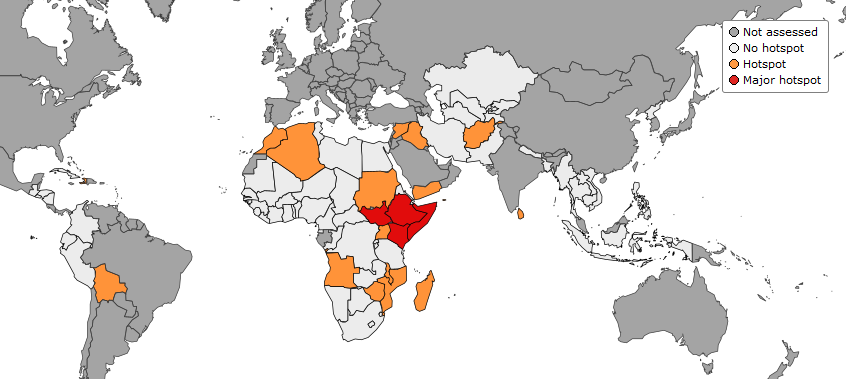
ASAP hotspot assessment July 2022
© EU 2022
Main findings of the July global overview:
- The main cereal season has been completed in the Southern Africa region. Aggregate cereal production is estimated close to the 5-year average, and approximately 10% lower than last year’s record high (FAO). Diminished cereal outputs in south-western Angola, Mozambique, southern Madagascar and southern Malawi are the main drivers of food insecurity in the affected areas of these countries.
- At the end of the first crop season in the bimodal areas of East Africa, crop and pasture failure due to extreme drought is likely to result in severe food crises in large areas of Somalia, Ethiopia, Kenya, northern Uganda and South Sudan. A combination of factors (conflict, climate extremes, economic shock, rising food and energy prices) is pushing millions towards starvation in East Africa, in particular in Ethiopia, Kenya, Somalia, South Sudan and Sudan.
- In North Africa, at the end of the winter wheat season, prolonged drought caused crop failure and low cereal yields throughout Morocco and in the western part of Algeria. Latest yield forecasts indicate wheat and barley yields lower than 50% of the 5-year average in Morocco, and approximately 20% below the 5-year average in Algeria. Low production of winter wheat in one or more countries in North Africa is of particular concern given the region’s high dependence on cereal imports from Ukraine and Russia. Similarly, in the Middle East, prospects for winter cereals are very poor in the north of Syria and the north and east of Iraq, due to low rainfall and poor socio-economic conditions (and irrigation restrictions in Iraq) since autumn 2021. In Iran, prospects are mixed: close to average in the north and below average in the south and east. In Yemen, sorghum and wheat are in mixed condition, with below-average biomass in the highlands.
- In West and Central Africa, crop conditions are generally favourable in the bimodal southern parts of the region, thanks to average to above-average rainfall throughout the past couple of months. Cumulative rainfall in June has been positive in most areas of the Sahel. However, a rainfall deficit in the first two dekads of July has resulted in below-average vegetation conditions in western Mali, south-eastern Burkina Faso and parts of Chad. The ongoing agricultural season is threatened by the insecurity and armed conflict that continue to affect livelihoods and impede access to croplands, as well as by the rise in prices for agricultural inputs, in particular fertilisers.
- In Central Asia, the harvest of winter crops is nearing completion, and prospects are favourable. In Kazakhstan and Afghanistan, biomass of spring cereals is below average due to water scarcity. In South Asia, heavy rainfall in July has been favourable for kharif crops in Pakistan. In Bangladesh, harvests of Boro rice were completed in June and are estimated to be 5% above the 5-year average (FAO). In Sri Lanka, second (yala) rice and maize crops are in good condition despite fertiliser and fuel shortages due to a serious economic crisis.
- In South-East Asia, moisture conditions continue to be favourable for planting and growth of wet season rice. In north Vietnam, winter/spring rice has been harvested with good prospects. In Indonesia, planting and growth of dry season rice is underway under favourable moisture conditions. In North Korea, crop biomass is close to or above average thanks to good rainfall, in particular at the end of June.
- In Central America and the Caribbean, planting of rice in Honduras, and planting of sorghum in El Salvador and Honduras, is being completed under unfavourable conditions. In Nicaragua, aggregate production of rice, maize and sorghum is expected to be above last year. Vegetation conditions remain below average in many cropping areas across Haiti, and a combination of poor rainfall and economic constraints point to poor harvest expectations. Very high prices for the main staple foods are observed in all countries, particularly in El Salvador, Nicaragua and Haiti.
The next assessment is scheduled for the end of August 2022.
Details
- Publication date
- 3 August 2022
- Author
- Joint Research Centre
